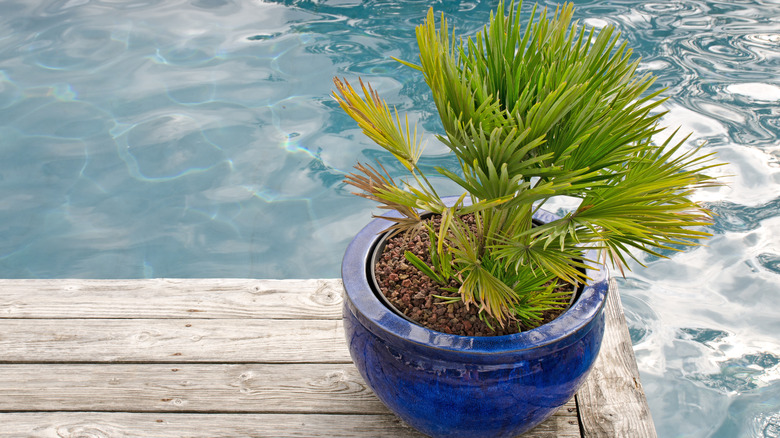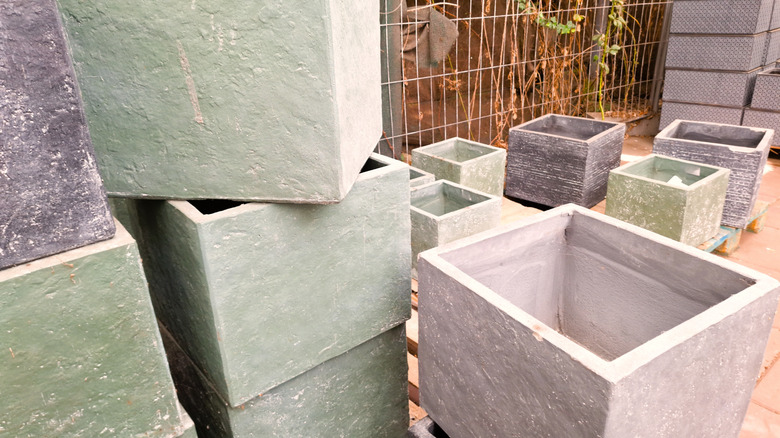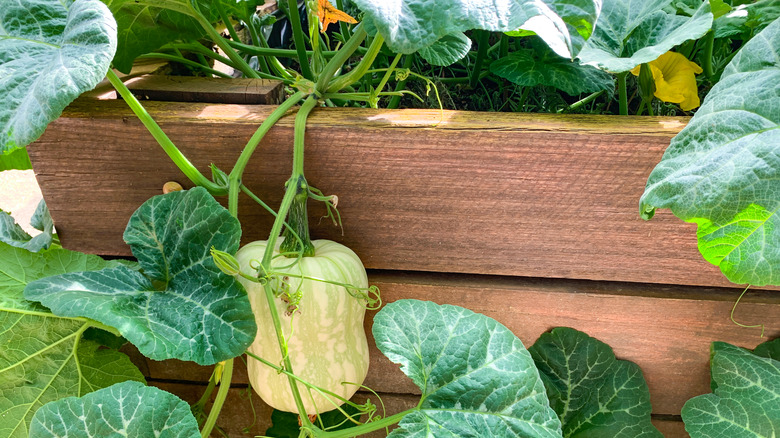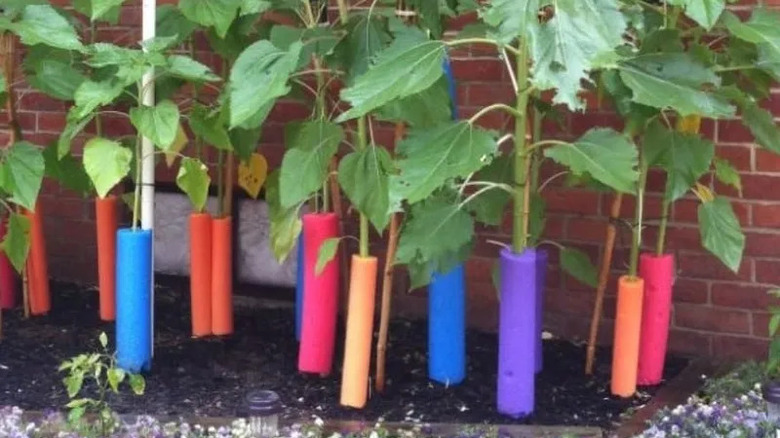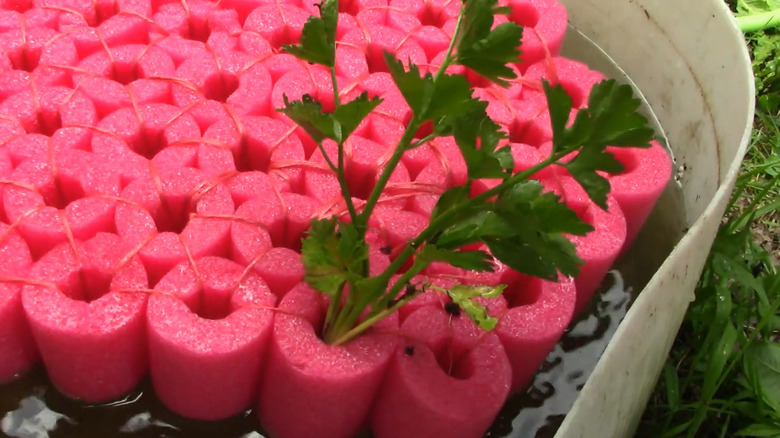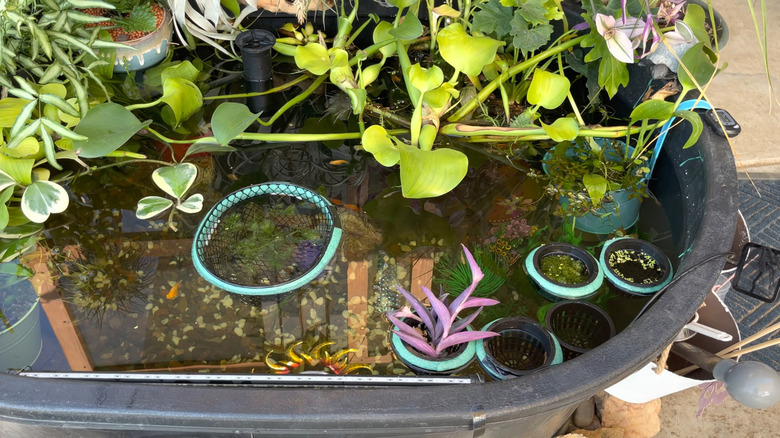5 Brilliant Ways To Hack Your Garden Planters With Pool Noodles
We may receive a commission on purchases made from links.
It's that time of year again when half of most households are daydreaming about the pool and the other half about planters and the greenery they contain. And occasionally, one person in the house is combining the two with a lightbulb-shaped pool noodle. It's a natural enough pairing, pool noodles and planters. The noodles bring lots to the party — padding, buoyancy, waterproofness, a reasonable amount of strength, and economy. Planters don't bring anything new because they are the party. There are tons of ways to noodle them up, and some of our favorites let you combine large and small pots, protect your plants, and bolster their growth of your flora.
Of course, you don't have to let the creativity end with the pool noodles. Beautiful planters can be made from household items from boots to bowls, baskets, and bathtubs. Bring new, green life to pots and pans in the garden after they've outlived their original usefulness. Or manufacture something more grand by turning pavers into a custom modern planter.
Safely nesting pots inside large planters
The basic hack here is bringing a stylish oversized planter down to earth with pool noodles. Start by adding some bricks to the bottom of the vessel to ensure that the foam sticks don't block any drainage holes. Then coil a few noodles inside — as many as you need to snugly hold your plant's container inside the larger one. If both the inner and outer pots are ceramic, the sticks should provide plenty of insulation to keep them from banging together and chipping or cracking. Obviously, this works best with relatively small plants in fairly large containers. Bigger plants might need the full space of the pot for soil, while smaller pots don't need the inner pot at all. TikTok maker of "completely unpredictable content" @lifeon_deerdrive likes the portability of this solution, noting that you can take the inner vessel out at the end of the season and bring it inside or otherwise protect it from winter weather.
Large outdoor planters are nothing new, but big pots — and especially concrete planters — are emerging as an indoor trend as well. They can be statement pieces or can serve an architectural function, helping to define a space. Sometimes the containers hold big plants like trees, but they tend to have an impact no matter what they hold.
Protect vining and trailing raised bed plants
Raised beds bring the charms of container gardening to a more productive and naturalistic growing approach. And, as with container plants, anything in a raised bed is apt to make a break for it at some point. Often, species with any sort of vining or trailing habit will quickly escape the bounds of this type of gardening. (Trailing plants are those that spread out but don't root at nodes along their length.) A stem lying against a raised bed's frame is susceptible to abrasion because of movement caused by wind and gardeners passing by. When there are heavy fruits on the trailing end of the stem, this wearing can become severe and damage the plant.
The solution dreamt up by @rooftop2table is to use a pool noodle to insulate the edge underneath any part of a plant that is at risk. Start by cutting down the length of the foam stick, all the way into the center hole. Afterward, push the split side tight over the wall of the raised bed where trailing is breaking over. You could, of course, line all the sides with pool noodles, but it's not generally necessary.
Staking lanky plants
There are a lot of reasons that plants can get too tall for their own good. A sun-loving plant on the wrong side of a house or nearby competing plants might be seeking additional light. Plants bred to grow high in the midst of a large field might be too weak to withstand wind without the windbreak provided by hundreds of neighbors. Leggy seedlings often grow, for a time at least, into leggy mature plants that can have difficulty remaining upright.
Enter the humble pool noodle, which can be slipped around the stem of a tall plant to provide support, while also protecting the stem from damage. The Gigi Clean Instagram account shows this tip in action, citing its effectiveness for young, more fragile plants. The noodle forms a sort of semi-rigid exoskeleton stake with enough elasticity so the plant doesn't break itself against it in a stiff wind. It also allows for vertical growth — something stakes aren't always great at.
Rooting for tomato suckers
Rooting a cutting often involves strategies borrowed from hydroponics because, well, it often is hydroponics. This trick not only uses water in a very hydroponic-y way, but it also uses sliced cross-sections of pool noodles in a manner familiar to many of the technique's practitioners. It's used by TikToker @_thatgardenchick_ for tomato plants, but this trick should work with most plants whose cuttings can grow roots in water.
If you have more than a few tomato plants — or sometimes even one — it's easy to get overwhelmed by suckers and tempted to stick in some water to clone a favorite variety. Tomato fans know that suckers, which are pruned away to control the growth habit of the plant, will root readily in plain water with no nutrients and be ready to transplant to soil in no time. When you're pruning, it's common to trim dozens, or even hundreds, of suckers. To grow these into viable new plants, cut a pool noodle into doughnut-shaped pieces and put a few slits along the perimeter of each one. These will hold each sucker's stem and keep the leaves above water while the submerged part starts to form roots. Easy-peasy and dirt cheap.
Floating an idea for aquatic plants
When YouTuber Dawn Champion brings flotation devices to her garden, it's because her plants wouldn't have it any other way. She puts floating plants from a patio pond into floating baskets — mostly net pots, a standard fixture of hydroponics — and attaches long sections of pool noodle around the perimeter to keep the vessels afloat. The idea is to protect fragile floating plants from various disturbances, and it's a great idea. Larger floating baskets for ponds can be bought on Amazon for upwards of $40, but you could easily create something similar for less than $4 with a one-buck pool noodle and something like a mesh paint strainer ($4.27 for two at Home Depot).
Because what you're dealing with here is a self-sufficient little hydroponic mechanism, it's not hard to imagine adapting this idea for a number of related plant purposes. By pushing the noodle slice a little further down the net pot, for example, you could keep a lot of the net pot's support above water. Then just drop a few cuttings into it at a time to start root development.
